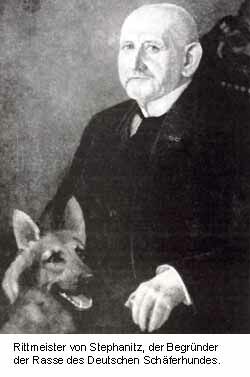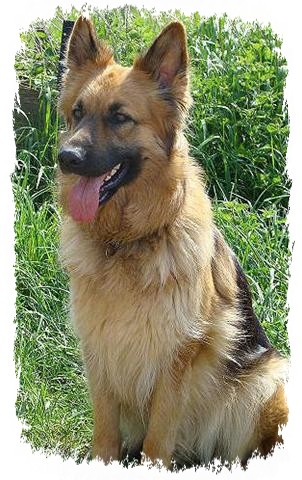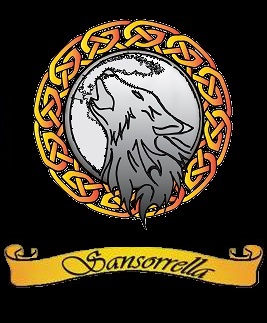
German Shepherd Dog

|
"Bracken" - Sanscott Careless Whisper to Sansorrella 18 month old gold sable longcoat |

Origins (courtesy of Wikipedia.com)In Europe during the 1800s, attempts were being made to standardise breeds. The dogs were bred to preserve traits that assisted in their job of herding sheep and protecting flocks from predators. In Germany this was practiced within local communities, where shepherds selected and bred dogs that they believed had traits necessary for herding sheep, such as intelligence, speed, strength, and keen senses of smell. The results were dogs that were able to perform admirably in their task, but that differed significantly, both in appearance and ability, from one locality to another. To combat these differences, the Phylax Society was formed in 1891 with the intention of creating standardised dog breeds in Germany. The society disbanded after only three years due to an ongoing, internal conflict regarding the traits that the society should promote; some members believed dogs should be bred solely for working purposes, while others believed dogs should be bred also for appearance. While unsuccessful in their goal, the Phylax Society had inspired people to pursue standardising dog breeds independently. Max von Stephanitz, an ex-cavalry captain and former student of the Berlin Veterinary College, was one such ex-member. He believed strongly that dogs should be bred for working.
|
 Horand von Grafrath, the first GSD pictured with Max von Stephanitz the creator of the breed (courtesy of Wikipedia) |
In 1899, Von Stephanitz was attending a dog show when he was shown a dog named Hektor Linksrhein. Hektor was the product of many generations of selective breeding and completely fulfilled what Von Stephanitz believed a working dog should be. He was pleased with the strength of the dog and was so taken by the animal's intelligence and loyalty, that he purchased it immediately. After purchasing the dog he changed its name to Horand von Grafrath and Von Stephanitz founded the Verein für Deutsche Schäferhunde (Society for the German Shepherd Dog). Horand was declared to be the first German Shepherd Dog and was the first dog added to the society's breed register. Horand became the centre-point of the breeding programs and was bred with dogs belonging to other society members that displayed desirable traits. Although fathering many pups, Horand's most successful was Hektor von Schwaben.. Hektor was inbred with another of Horand's offspring and produced Beowulf, who later fathered a total of eighty-four pups, mostly through being inbred with Hektor's other offspring. Beowulf's progeny also were inbred and it is from these pups that all German Shepherds draw a genetic link. It is believed the society accomplished its goal mostly due to Von Stephanitz's strong, uncompromising leadership and he is therefore credited with being the creator of the German Shepherd Dog.
|

|
"Beau" - Ballynabola Intrepid at Sanscott |
PopularityWhen the UK Kennel Club first accepted registrations for the breed in 1919, fifty-four dogs were registered, and by 1926 this number had grown to over 8,000. The breed first gained international recognition at the decline of World War I after returning soldiers spoke highly of the breed, and animal actors Rin Tin Tin and Strongheart popularised the breed further. The first German Shepherd Dog registered in the United States was Queen of Switzerland; however, her offspring suffered from defects as the result of poor breeding, which caused the breed to suffer a decline in popularity during the late 1920s. Popularity increased again after the German Shepherd Sieger Pfeffer von Bern became the 1937 and 1938 Grand Victor in American Kennel club dog shows, only to suffer another decline at the conclusion of World War II, due to anti-German sentiment of the time. As time progressed, their popularity increased gradually until 1993, when they became the third most popular breed in the United States. As of 2009, the breed was the second most popular in the US. Additionally, the breed is typically among the most popular in other registries. The 'German Shepherd' Dog body is built very able when it comes to athletic ability. They are commonly competing in shows and competitions such as 'agility trials'. |
|
"Reba" Ballynabola Eternity at Sansorrella |
NameThe breed was named Deutscher Schäferhund by Von Stephanitz, literally translating to "German Shepherd Dog". The breed was so named due its original purpose of assisting shepherds in herding and protecting sheep. At the time, all other herding dogs in Germany were referred to by this name; they thus became known as Altdeutsche Schäferhunde or Old German Shepherd Dogs. Shepherds were first exported to Britain in 1908, and the UK Kennel Club began to recognize the breed in 1919. The direct translation of the name was adopted for use in the official breed registry; however, at the conclusion of World War I, it was believed that the inclusion of the word "German" would harm the breed's popularity, due to the anti-German sentiment of the era. The breed was officially renamed by the UK Kennel Club to "Alsatian Wolf Dog" which was also adopted by many other international kennel clubs. Eventually, the appendage "wolf dog" was dropped. The name Alsatian remained for five decades, until 1977, when successful campaigns by dog enthusiasts pressured the British Kennel club to allow the breed to be registered again as German Shepherd Dogs. Modern breedThe modern German Shepherd is criticised for straying away from von Stephanitz's original ideology for the breed: that German Shepherds should be bred primarily as working dogs, and that breeding should be strictly controlled to eliminate defects quickly. Critics believe that careless breeding has promoted disease and other defects. Under the breeding programs overseen by von Stephanitz, defects were quickly bred out; however, in modern times without regulation on breeding, genetic problems such as colour-paling, hip dysplasia, monorchidism, weakness of temperament, and missing teeth are common, as well as bent or folded ears which never fully turn up when reaching adulthood. |
 "Lace" Creeksea Ursula at Sanscott |

pt
"Bracken" 10 month old pup Description German Shepherds are a medium sized dog which generally are between 55 and 65 centimetres (22 and 26 in) at the withers and weigh between 22 and 40 kilograms (49 and 88 lb). The ideal height is 63 centimetres (25 in), according to Kennel Club standards. They have a domed forehead, a long square-cut muzzle and a black nose. The jaws are strong, with a scissor-like bite. The eyes are medium-sized and brown with a lively, intelligent, and self-assured look. The ears are large and stand erect, open at the front and parallel, but they often are pulled back during movement. They have a long neck, which is raised when excited and lowered when moving at a fast pace. The tail is bushy and reaches to the hock. German Shepherds can be a variety of colours, the most common of which are the tan/black and red/black varieties. Both varieties have black masks and black body markings which can range from a classic "saddle" to an over-all "blanket." Rarer colour variations include the sable, all-black, all-white, liver, and blue varieties. The all-black and sable varieties are acceptable according to most standards; however, the blue and liver are considered to be serious faults and the all-white is grounds for instant disqualification in some standards. This is because the white coat is more visible, making the dog a poor guard dog, and harder to see in conditions such as snow or when herding sheep. German Shepherds sport a double coat. The outer coat, which is shed all year round, is close and dense with a thick undercoat. The coat is accepted in two variants; medium and long. The long-hair gene is recessive, making the long-hair variety rarer. Treatment of the long-hair variation differs across standards; they are accepted under the German and UK Kennel Clubs but are considered a fault in the American Kennel Club. Intelligence German Shepherds were bred specifically for their intelligence, a trait for which they are now renowned. They are considered to be the third most intelligent breed of dog, behind Border Collies and Poodles. In the book The Intelligence of Dogs, author Stanley Coren ranked the breed third for intelligence. He found that they had the ability to learn simple tasks after only five repetitions and obeyed the first command given 95% of the time. Coupled with their strength, this trait makes the breed desirable as police, guard, and search and rescue dogs, as they are able to quickly learn various tasks and interpret instructions better than other large breeds. Temperament German Shepherds are highly active dogs, and described in breed standards as self-assured. The breed is marked by a willingness to learn and an eagerness to have a purpose. Shepherds have a loyal nature and bond well with people they know. However, they can become over-protective of their family and territory, especially if not socialized correctly. An aloof personality makes them approachable, but not inclined to become immediate friends with strangers. German Shepherds are highly intelligent and obedient and some people think they require a "firm hand", but more recent research into training methods has shown they respond as well, if not better, to reward based training methods.
|
|
"Bracken" 5 months old "In all things of nature there is something of the marvellous" Aristotle |


![]() Sansorrella 2010 All rights reserved
Sansorrella 2010 All rights reserved